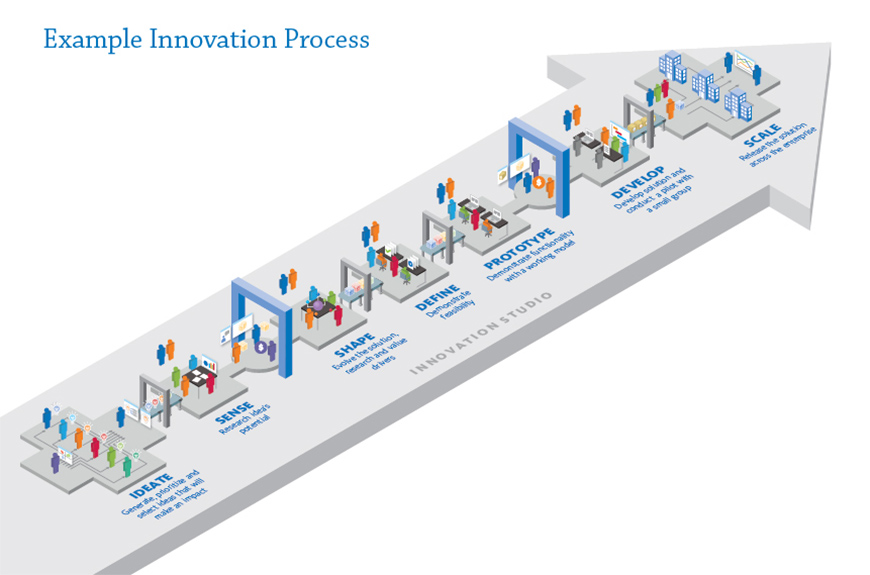Is your innovation process creating value for your organization, or is it just busy work?
Innovation doesn’t just happen by accident (I mean sometimes it does, but we can’t just rely on fate, right?). For organizations to find, develop, and most importantly prioritize new and innovative ideas, they need an innovation process. And while there is no one-size-fits-all solution, there are some common elements and problems to solve.
Learn more about our approach to change communication, download “Communicating Change: Four Ideas You Haven’t Tried.”
When designing an innovation process there are a handful of upfront questions you have to answer.
1. Will your innovation process be centralized, distributed, or a hybrid?
Centralized innovation centers can be more efficient, combining resources and ensuring coordination and alignment between efforts. Distributed processes can keep fresh ideas close to the business units and experts.
Many companies opt for a hybrid model. They use business units and operational areas to generate ideas, evaluate and develop ideas with a centralized team, and then pilot and prototype back in the business units.
2. Will you define innovation-focus areas or give contributors free rein?
Providing direction during the ideation process can be invaluable for organizations. First, it makes it more likely that the ideas you receive will be of value to the organization. Telling employees to focus their efforts on consumer experience versus operational efficiency may result in better alignment to strategic or growth goals.
Second, the best ideation often happens with some structure. Being asked to come up with “new ideas” is often hard for people, but being asked to solve a specific problem like “how can we add moments of delight for our customers to our existing business processes” can spur dozens of ideas.
On the other hand, too much focus can put too many constraints on creative thinking. This can discourage contributors from nominating ideas that are too far outside of the bounds.
3. What will your intake system be?
For many enterprises, an idea intake is a balancing act. If your system is too broad and too easy to submit ideas, you’ll end up with an unmanageable number of half-baked suggestions. But an intake system that is too narrow will discourage team members from participating.
Consider the right amount of detail needed to evaluate an idea, without weighing it down.
Here is a solid checklist that you can adjust to your needs:
- Idea name
- 2 to 3 sentence description of the new process, offering, or experience
- 1 sentence about the problem solves/opportunity realized by the idea
- Description of who will benefit (external and internal audiences)
- Capabilities, systems, tools, processes, people, etc. need to bring the idea to life
Also, consider an intake system that allows multiple paths to submission—for instance, a digital form, but also the occasional town hall or workshop format that helps to spark ideas.
4. How many phases do you need?
Most innovation processes are stage-gated in some way. Some processes involve dozens of phases, while others only a few. Use phases to track ideas. They also keep non-viable ideas from sucking up valuable resources. But obviously, no one wants an overly complex process, so when designing your phases, be on the lookout for the following signifiers:
- Funding or resource requests. Any time ideas are getting more money, more people, or more tools, it should be a new phase.
- Change in players. If you’re inviting in new team members, collaborating with other teams, or if there is a hand-off between teams, it’s probably a new phase.
- Deliverables or artifact creation and review such as pain point analysis, consumer research, competitive benchmarking, market research, proof of concept models, business cases, or pilot feedback should be the output of a phase and a sign to start a new one.
In the example above, you can see a seven-phase innovation process. It begins with Ideate, where ideas are generated. Sense is the second phase, where ideas are quickly vetted for potential. After pitching the idea, the next three phases: Shape, Define, and Prototype, take an idea from intangible and murky, to fully fleshed out with a clear value. The last two phases: Develop and Scale test an idea and work out the kinks before launch. The two large arches represent key stage gates. Apply additional resources here. Any idea that fails to complete a phase, or doesn’t pass the stage-gate evaluation either goes back or is abandoned.
5. How will you govern your innovation process?
All processes need governance. For an innovation process, you need a way to evaluate that a team or idea has successfully completed a phase and is ready to move to the next phase. You also need oversight of the whole system. It’s important to evaluate the design of the process periodically, from the innovation focus-area setting to the intake process, to the phases and process activities. Is your innovation process creating value for your organization or is it just busywork? Are the organization leaders and teams engaged in the process or are they bypassing it to get ideas through backdoors? Evaluating and re-designing as needed is the key to creating a functional innovation process.
Once you’ve designed your innovation process, the final and most important consideration is how you communicate it to your organization. Whether or not all of your employees participate, or only a select few, everyone should be aware of how your company approaches innovation. If your employees don’t know about your innovation process, you risk having rogue innovation processes or ideas pop up. Or worse, creating a culture where employees think that innovation and growth aren’t valued or desirable.
I’ve written in the past about communicating for change, and the program described here works really well for rolling out a new innovation process or promoting an existing but hidden one. A visual diagram, like the example above, quickly lays out the process phases, shows who is involved and what activities are taking place. It gives necessary detail without overwhelming. But however you choose to communicate about your innovation process, the key is to be as clear, transparent, and specific as possible, to best engage your organization.
 If you want to read more about designing your innovation process, as well as the latest news on organizational transformation, employee experience, and more, sign up for our monthly newsletter!
If you want to read more about designing your innovation process, as well as the latest news on organizational transformation, employee experience, and more, sign up for our monthly newsletter!

